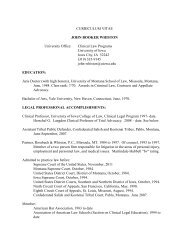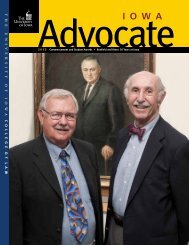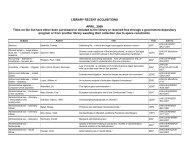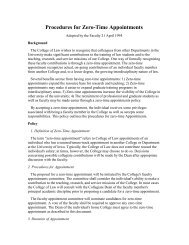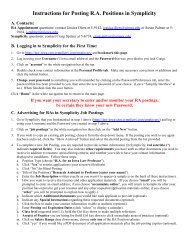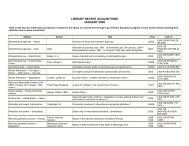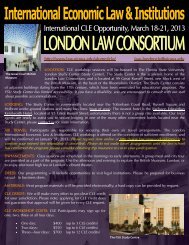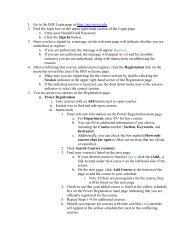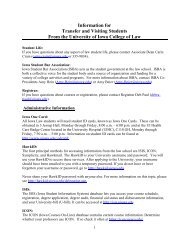Free Writing Steve Thel*
Free Writing Steve Thel*
Free Writing Steve Thel*
- No tags were found...
Create successful ePaper yourself
Turn your PDF publications into a flip-book with our unique Google optimized e-Paper software.
Thel Final9/18/2008 1:11 PM2008] <strong>Free</strong> <strong>Writing</strong> 961writing, and criminal sanctions are available for willful violations of section 17(a). 95Perhaps most importantly, investors are unlikely to be harmed by false free writinganyway. Before an investor is sent free writing, she has to be sent a section 10(a)prospectus. While that prospectus need not disclose all material information, it does haveto disclose everything that the SEC requires, and the SEC requires most everything thatanybody thinks is material. If that statutory prospectus contains false statements ofmaterial information, the investor has ample remedy under sections 11 and 12(a)(2).Since investors will have that statutory prospectus to check against free writing, sellershave little incentive to lie in free writing. In any event, investors can protect themselvesby using the section 10(a) prospectus to detect misleading free writing. Although thereare good reasons not to require buyers to exercise due diligence, it is not surprising thatcourts have denied recovery for false statements when a statutory prospectus or otherformal document provided before the sale contained the truth, on the theory that anyreliance could not have been justified. 96 There is also something to be said forencouraging investors to read statutory prospectuses, and the SEC itself requires that freewriting prospectuses advise recipients that they should, as they say, “read before youinvest.” 97 Moreover, investors who know that false free writing is not actionable undersection 12(a)(2) are less likely to rely upon it blindly (and, conversely, if false freewriting were actionable under section 12(a)(2), they would have every reason not to readtheir section 10(a) prospectuses, inasmuch as recovery under section 12(a)(2) depends ontheir ignorance of the truth). Finally, if the securities markets are even reasonablyefficient, accurate information in statutory prospectuses will swamp the effect of falsestatements in free writing, so that even investors misled by free writing pay fair prices.95. Securities Act of 1933 § 24, 15 U.S.C. § 77x (2000).96. See, e.g., Carr v. CIGNA Sec., Inc., 95 F.3d 544, 547 (7th Cir. 1996) (denying claim based onplaintiff‟s receipt of documents warning of risky investments); Eckstein v. Balcor Film Investors, 8 F.3d 1121,1131-32 (7th Cir. 1993) (noting cautionary language in prospectus); Brown v. E.F. Hutton Group, Inc., 991 F.2d1020, 1030-33 (2d Cir. 1993) (same); Zobrist v. Coal-X, Inc., 708 F.2d 1511, 1518 (10th Cir. 1983). Thesecases were brought under Rule 10b-5 and do not involve challenges to free writing under section 12(a)(2), butof course there are no section 12(a)(2) cases challenging false free writing. If free writing were actionable undersection 12(a)(2), these cases might be extended to section 12(a)(2) under the section‟s requirement that thepurchaser not know of the untruth, but see sources cited supra note 52 (discussing effect of correction undersection 12(a)(2)), or on the theory that prospectus disclosure renders any misrepresentation in free writingnonmaterial in light of the total mix of available information. See TSC Indus. v. Northway, Inc., 426 U.S. 438,449 (1976) (requiring “a showing of substantial likelihood that, under all the circumstances, the omitted factwould have assumed actual significance in the reasonable shareholder‟s deliberations”); In re Hyperion Sec.Litig., [1995-96 Transfer Binder] Fed. Sec. L. Rep. (CCH) 98,906 (S.D.N.Y. July 14, 1995) (oralmisrepresentation at road show not actionable under section 12(a)(2) when statutory prospectus disclosed truthand bespoke caution).97. See Rule 433(c)(2)(i), 17 C.F.R. § 230.433(c)(2)(i) (2007) (requiring free writing prospectuses tocontain a legend stating that “[t]he issuer has filed a registration statement (including a prospectus) with theSEC for the offering to which this communication relates. Before you invest, you should read the prospectus inthat registration statement”); Rule 163(b), 17 C.F.R. § 230.163(b) (2007) (stating similar requirements forprefiling communications by well-known seasoned issuers); Rule 482(b)(1)(i), 17 C.F.R. § 230.482(b)(1)(i)(2007) (stating similar requirements for section 10(b) prospectuses of registered investment companies (e.g.,mutual funds)).




